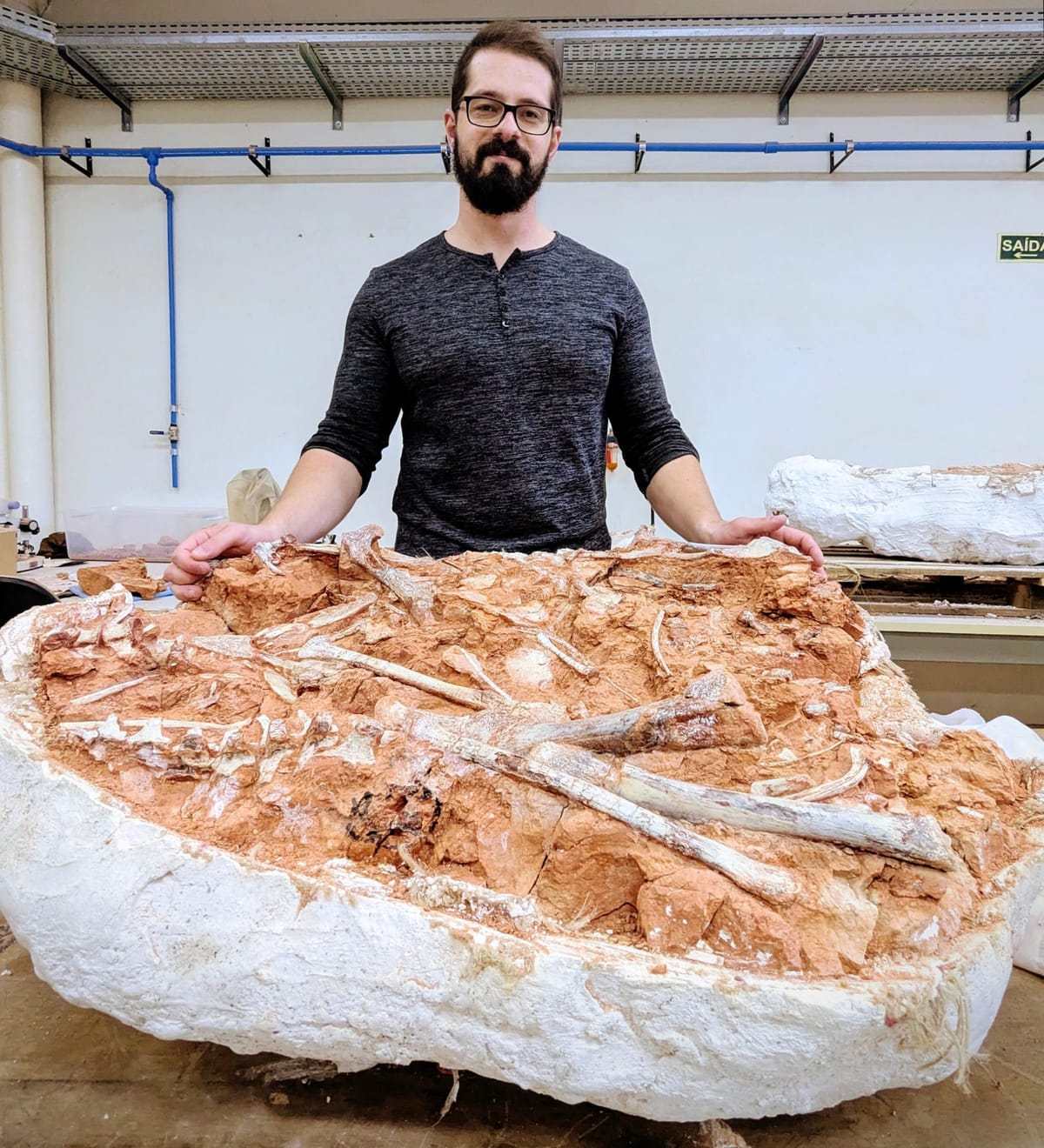In late April, torrential rain brought biblical floods to southern Brazil. The historic deluge, largely part attributed to climate change, was the worst the state of Rio Grande do Sul had seen in 80 years, causing widespread infrastructure damage, population displacement, and over 100 fatalities in the eastern and central regions. But as the stormwater washed away homes, agricultural livelihoods, and precious topsoil, the downpour brought a different kind of discovery to the fore: dinosaur bones.
Brazil’s agricultural heartland is also a cornucopia of extraordinary fossils. Smack dab in the center of Rio Grande do Sul, a four-hour drive from the state capital, is the municipality of São João do Polêsine, a hamlet so tiny and remote that visitors like myself were warned that we’d have trouble hailing a taxi to make it out of there. A rich tract of paleontological treasures skirts the town and runs through private property. The wet, erratic climate and lush vegetation make São João do Polêsine an unlikely place for preserving its paleontological records, but scientists have been converging here for years in search of age-old artifacts in the dirt.
And last August, nearly four months after the environmental catastrophe, I swung by São João do Polêsine for a similar reason — to see the most recent paleontological haul for myself.
Though the town didn’t experience flooding at the height of the storms, the voluminous rains grounded paleontological field operations to a halt. For two weeks, Rodrigo Temp Müller, a paleontologist at the Federal University of Santa Maria, waited antsily; once the rains abated, his team headed to their usual dig site to survey the aftermath. A few eroded but unmistakable bones poked out from the surface. Within a few hours of scrabbling, the researchers identified the bones to be from the Herrerasauridae family, some of the oldest dinosaurs in the world.
Around 230 million years ago, the Herrerasaurus — Müller described it to me as a lookalike of the velociraptors from the movie Jurassic Park — terrorized its subordinates on the food chain wherever it prowled. It was the dawn of the dinosaurs, and their ruler was the Herrerasaurus, which enjoyed a size advantage compared with the rest of the playing field. Most dinosaurs during the Triassic were puny, measuring up to about three feet, or one meter, in body length. In comparison, king Herrerasaurus was about 20 feet (6 meters) in length and slightly chonkier than a modern-day polar bear.
Of course, that’s modest compared to the Tyrannosaurus Rex that arrived 165 million years later, a leviathan that spanned 40 feet from nose to tail. But the Herrerasaurus was the first behemoth for the books, and its evolutionary strategy was one that later generations of dinosaurs would emulate.
The Herrerasaurus is ancient even among an ancient race. Its lineage has long gone extinct; no modern creature is a direct descendant of the Herrerasaurus. If the evolutionary picture of life on Earth was organized into a family tree, Herrerasauridae is like that great-great-great grandaunt who never had children.

Scientists still don’t know why Herrerasaurus died out, or how it went about while it lived, but the 440-pounds-or-so rock that Müller’s team pulled out of the earth could lead the field one step closer to the answers. The fossil that Müller found was of a juvenile, because parts of the skeleton were not completely fused as they would have been in a fully-grown adult. The researchers estimated the individual grew to eight feet in length.
The most tantalizing find among the jumble of bones was the skull. After all, it’s the closest that today’s researchers can come face-to-face with a beast that preceded them for millennia. Reconstructing its brain could shed light on Herrerasaurus behavior, Müller told me. His early examination of the skull revealed that the brain was probably crocodile sized. It had a well-developed parafloccular cortex that allowed the Herrerosaurus to gauge the position and movement of its prey with deadly accuracy. The researchers are still teasing out the results and will plan to publish their complete findings in a few years.
Though it was hard for me to tell from the bone heap embedded in stone, the Herrerasauridae specimen revealed by Brazil’s rains is near-complete, skull and all. In fact, it’s only the second such that paleontologists have found to date. “Something this complete is not unheard of, but incredibly rare for these really early dinosaurs,” says Christopher Griffin, a paleontologist at Princeton University who wasn’t involved in the discovery. “To have almost the entire skeletal anatomy preserved of this individual is very, very important.” Such a relic would fill in the many blanks on Herrerasaurus anatomy that previous researchers have cobbled together from partial skeletons thus far. Plus, having another almost-whole specimen helps get around the N=1 problem; in other words, to allow scientists to understand the extent of variation that can exist between Herrerasauridae members amidst its clade-defining commonalities.
As Müller explained his findings, I was struck by the home-grown nature of Brazilian paleontology. A century ago, researchers from the Global North or the West, have swooped into developing countries and exploited its natural history; among their transgressions, looting fossils and claiming the discoveries as their own. But today, Brazil’s paleontological scene is thriving, thanks to government protections and efforts to decolonize research. Any fossil found in Brazil has to remain in Brazil. International paleontologists need to engage local scientists if they want to conduct research on Brazilian soil. The country could serve as a shining example for how the rest of the world can throw off paleontology’s colonialist past and allow locals to rightfully lead the way.

The latest Herrerasaurus bones are a fortuitous find, for sure, but to what extent can abnormal rains actually be good for paleontology? “Although the rain helped reveal the fossil, it actually accelerated the erosion process,” Müller said. It turns out, too much rain can turn into a bad thing.
“Erosion in paleontology is a double edged sword,” Griffin concurs. The first bones that the researchers saw were significantly damaged by the glut of rain; luckily the more informative ones were still mostly buried by the time the team started excavating in earnest. In more drastic cases or for smaller specimens, the rains could have washed away bone fragments for good, destroying any chances of a new paleontological discovery, and we’d be none the wiser for it.
If he could choose, Müller told me he’d prefer that the torrential rains never happened at all. Under the usual conditions, the researchers would have been in a position to monitor the grounds more effectively. “We would probably have discovered this fossil anyway,” Müller said, even if it meant new findings might take longer.
As climate change brings heavier and more frequent storms, researchers are more worried about the conditions of yet-undiscovered fossils than they’re counting on their luck to make more finds. Overall, the bad seems to outweigh the good, as climate change turns the paleontological enterprise into a Russian roulette rather than an exercise of patience and perseverance.
Barring an environmental disaster, climate change may not directly affect the day-to-day of dinosaur discovery, says Griffin, but it leaves an indelible mark on expedition logistics. For instance, drought might disrupt the supply chain of food for excavating teams. If researchers are forced to stay indoors due to inclement conditions, the number of scratched field days can add up across a decade. Not to mention, light to no rain would make for a more pleasant excavation experience than a drencher.
Among the myriad life-and-death problems caused by climate change, the paleontological ones probably don’t rank so serious. Even my canceled flight out of Rio Grande do Sul the next day due to climate-driven excessive turbulence seemed more harrowing in comparison to finding a rock in the ground. But to think that a dusty secret, laying in oblivion for millions of years, finally surfaces for an instant, only to disappear in the next blink before humans can chance upon it — that is its own kind of tragedy.
(This reporting for this story was partially supported by a grant from the Pulitzer Center.)




